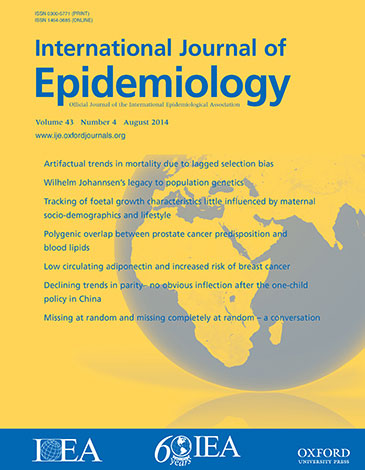Spatial Bayesian distributed lag non-linear models (SB-DLNM) for small-area exposure-lag-response epidemiological modelling
IF 6.4
2区 医学
Q1 PUBLIC, ENVIRONMENTAL & OCCUPATIONAL HEALTH
引用次数: 0
Abstract
Abstract Background Distributed lag non-linear models (DLNMs) are the reference framework for modelling lagged non-linear associations. They are usually used in large-scale multi-location studies. Attempts to study these associations in small areas either did not include the lagged non-linear effects, did not allow for geographically-varying risks or downscaled risks from larger spatial units through socioeconomic and physical meta-predictors when the estimation of the risks was not feasible due to low statistical power. Methods Here we proposed spatial Bayesian DLNMs (SB-DLNMs) as a new framework for the estimation of reliable small-area lagged non-linear associations, and demonstrated the methodology for the case study of the temperature-mortality relationship in the 73 neighbourhoods of the city of Barcelona. We generalized location-independent DLNMs to the Bayesian framework (B-DLNMs), and extended them to SB-DLNMs by incorporating spatial models in a single-stage approach that accounts for the spatial dependence between risks. Results The results of the case study highlighted the benefits of incorporating the spatial component for small-area analysis. Estimates obtained from independent B-DLNMs were unstable and unreliable, particularly in neighbourhoods with very low numbers of deaths. SB-DLNMs addressed these instabilities by incorporating spatial dependencies, resulting in more plausible and coherent estimates and revealing hidden spatial patterns. In addition, the Bayesian framework enriches the range of estimates and tests that can be used in both large- and small-area studies. Conclusions SB-DLNMs account for spatial structures in the risk associations across small areas. By modelling spatial differences, SB-DLNMs facilitate the direct estimation of non-linear exposure-response lagged associations at the small-area level, even in areas with as few as 19 deaths. The manuscript includes an illustrative code to reproduce the results, and to facilitate the implementation of other case studies by other researchers.用于小区域暴露-滞后-反应流行病学建模的空间贝叶斯分布式滞后非线性模型(SB-DLNM)
摘要 背景 分布式滞后非线性模型(DLNM)是模拟滞后非线性关联的参考框架。它们通常用于大规模多地点研究。在小区域研究这些关联的尝试要么不包括滞后非线性效应,要么不考虑地理上变化的风险,要么通过社会经济和物理元预测因子对较大空间单位的风险进行降尺度,而由于统计能力较低,对风险的估计并不可行。方法 在这里,我们提出了空间贝叶斯 DLNMs(SB-DLNMs)作为估算可靠的小区域滞后非线性关联的新框架,并在巴塞罗那市 73 个社区的气温-死亡率关系案例研究中演示了该方法。我们将与地点无关的 DLNMs 推广到贝叶斯框架(B-DLNMs),并将其扩展到 SB-DLNMs,将空间模型纳入考虑风险之间空间依赖性的单阶段方法中。结果 案例研究的结果凸显了将空间部分纳入小区域分析的好处。从独立的 B-DLNM 中获得的估计值不稳定、不可靠,特别是在死亡人数极少的社区。SB-DLNM 纳入了空间依赖关系,从而解决了这些不稳定性问题,使估算结果更加合理和一致,并揭示了隐藏的空间模式。此外,贝叶斯框架还丰富了可用于大面积和小面积研究的估算和检验范围。结论 SB-DLNMs 解释了小区域风险关联的空间结构。通过对空间差异建模,SB-DLNMs 有助于在小区域层面直接估计非线性暴露-反应滞后关联,即使在死亡人数少至 19 人的地区也是如此。手稿中包含一个说明性代码,用于重现结果,并方便其他研究人员实施其他案例研究。
本文章由计算机程序翻译,如有差异,请以英文原文为准。
求助全文
约1分钟内获得全文
求助全文
来源期刊

International journal of epidemiology
医学-公共卫生、环境卫生与职业卫生
CiteScore
13.60
自引率
2.60%
发文量
226
审稿时长
3 months
期刊介绍:
The International Journal of Epidemiology is a vital resource for individuals seeking to stay updated on the latest advancements and emerging trends in the field of epidemiology worldwide.
The journal fosters communication among researchers, educators, and practitioners involved in the study, teaching, and application of epidemiology pertaining to both communicable and non-communicable diseases. It also includes research on health services and medical care.
Furthermore, the journal presents new methodologies in epidemiology and statistics, catering to professionals working in social and preventive medicine. Published six times a year, the International Journal of Epidemiology provides a comprehensive platform for the analysis of data.
Overall, this journal is an indispensable tool for staying informed and connected within the dynamic realm of epidemiology.
 求助内容:
求助内容: 应助结果提醒方式:
应助结果提醒方式:


